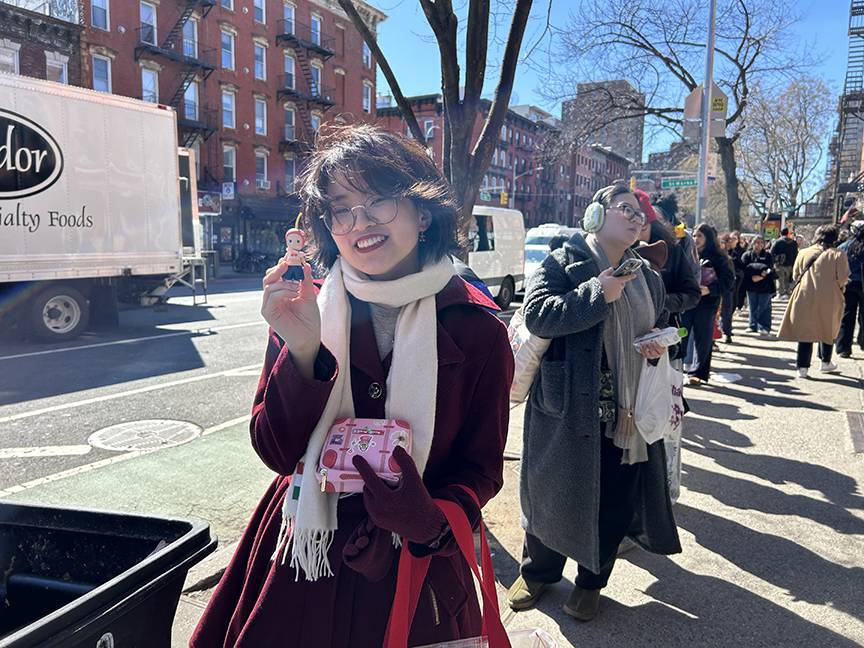It’s 11:30 a.m. on a chilly Friday, and the small children’s boutique on 9th Street won’t open for another half hour. Still, hundreds are lined up from the building’s entrance all the way down the street and around the corner of 1st Ave. Some have been waiting for over three hours, bringing folding chairs or food for their friends.
But they’re not here for a concert or to see a celebrity. They’re waiting to buy the new Sonny Angels: 3-inch-tall cherub figurines made by Japanese company Dreams Inc. Although “Sonnies” – as they’re colloquially referred to by their fans – have been around since 2004, in the past few years their popularity has skyrocketed, changing youth culture and small businesses.
One of these businesses is an.mé, a boutique with locations in the East and West Villages. Named after co-owners Annie and Melissa, the trinkets and toys an.mé is known for began as Annie’s toy collection, which she’s been adding to since childhood.
In 2024, CNN reported that, for the first time, adults were buying more toys for themselves than for any other age group. an.mé has been selling Sonny Angels since its founding in 2013, but
Annie noticed a steep rise in customers after COVID-19 lockdowns lifted. Many of the Sonny collectors in line say they began collecting during or after lockdown. Events like this release – or last summer’s meet-and-greet with Smiski, another popular figurine mascot – allow collectors who began their hobby online to meet each other in real life.
“Especially after the pandemic, [people] don’t get to meet each other,” Annie says. “You talk online, you don’t see people in person. This is a very nice way to bring people to communicate again, but in person, because now everybody shares the same interests.”

The line around the block may be a newer phenomenon, but as Annie explains, an.mé has found their “sweet spot” in effectively catering to such large crowds. Their past few years in the spotlight have given her and Melissa a better sense of the amount of inventory they need, or when extra staff should show up to help with crowd control – such as on days like today.
New editions of Sonny Angels are released at the same time worldwide every few months. That’s what the crowd is eagerly awaiting: the new Cherry Blossom series. There are multiple different figures in each Sonny Angel series, but customers don’t know which one they’ll get until after they’ve purchased and opened it. That’s because Sonny Angels are a type of figurine known as blind boxes. Their opaque cardboard packaging makes it possible to see the displayed options, but impossible to see which is inside.
But this mystery is part of the appeal to many collectors. For one, it’s a gamble. “I think the surprise factor has a lot to do with it,” Annie says. Getting a figurine you really wanted feels like “some kind of dopamine rush,” explains 23-year-old Chloe, who’s been waiting in line with her friends Eden, Itzel, and Rachel since 9 am.
But more importantly, it’s formed a community of collectors who have made friends through their love for Sonnies. Often, collectors find they’ve bought a figurine they already have or don’t really want. At trading events, they can meet other fans, swap figurines they don’t want for ones they do, and make lasting friendships.
“There’s always going to be somebody that wants something that you don’t. And I think that’s the best part about it, because everyone’s happy at the end of the day,” says Itzel, 18, who hosts Sonny Angel trading events. “You always make new friends, too. Everybody switches Instagrams. We have group chats.”
It’s a family thing
For some, Sonny collecting also forms stronger bonds with their friends and family. Many collectors in line say they were inspired by their friends to start a collection, and some young women say they collect with their moms or siblings. “My mom makes crochet clothes for Sonny Angels, which got us into it,” says Rachel, 23, as Eden, 18, exclaims “Oh, we’re moving!” It’s finally noon, and the line is beginning to be escorted into the store.
Each Sonny Angel box reads, “He may bring you happiness.” And for many, that’s why they keep their favorite Sonnies alongside them. Jenny, a 26-year-old barista waiting for the new release, says she keeps one at work to remind her on stressful days “this might be bad, but I have something that makes me happy.” As Annie explains about her own collection, “It’s almost like an emotional support type of thing.”
Sonny Angels may be the most popular blind box, but they’re far from the only option. Smiski – 3-inch-tall, glow-in-the-dark alienlike figures commonly seen peeking around corners or holding pencils – are another common request at an.mé. Ronnie, 23, says her Smiski “add a little happy moment around the house.” She adds, “Some people view it as clutter. And I get it. But to me, that [clutter] makes me happy.” To her, Smiski and Sonny Angels are a type of “dopamine décor”: tiny things that make one smile or remember fun moments when they see them at work or home.
“I go get Smiskis when I need a pick-me-up because it’s so accessible,” Ronnie says. “There are a few Smiskis I look at and am like, ‘wait, this had made my day. I got this Smiski I wanted when I was having a rough work day or just a rough mental day.’” Ronnie’s Smiskis also remind her of shared moments with her friends, who collect with her.
Sonny Angels “make me happy, even though I spend too much money on them,” laughs Eden. “It’s just like a little reward I give myself after a long or hard day or passing a test or something.”
For others, the doll-like aspect of Sonnies is a way to stay connected to their youth. “Girls grow up and we tend to leave our Barbies behind,” says 22-year-old Ingrid, who has been waiting in line since 9 a.m. “But now, with having the Sonny Angels, we have a little something to carry around to remind us of when we were in our childhood.”
She started with one
20-year-old Alanna started like many of her fellow collectors. “I was like, ‘I’ll just get one. Just a little guy to really be my one and only guy,’” she says. “And then it just went from there.” Alanna now has over 60 Sonnies, and carries her favorites with her in a small case. Other collectors opt to carry their favorites on keychains or in specially-designed clear slotted tote bags. “I always like to carry little things in my bag, too,” says Annie.
Alanna says her collection symbolizes her place in a larger community: “I’ve gone to trading events, meetups in Washington Square Park, and other events, and it’s allowed me to connect with so many people.”
“The whole point of this is why we have physical stores,” says Annie, who attends every release an.mé hosts. “I love to involve people. We sell a lot faster online, but then you don’t get to meet people, you know?” Ronnie says she loves getting the chance to talk to fellow collectors in line. “I try to make it a bonding moment with people I don’t know,” she says, explaining she’s made friends and even gone to a concert hosted by a girl she met at an.mé.
“Part of the joy of collecting is the connection with other people,” says Jessica, 29, who began collecting blind box figurines in 2013. She’s seen how the culture around them has changed over the years. As their popularity has grown, “a lot of people have been reselling and really focusing on the material aspect,” she says, explaining much of the “rush towards blind boxes” came from how coveted “trinket collections” have become on social media.
“A lot of people wanted that fast. The whole idea of having that [collection] was that it grew organically over time. It wasn’t something that you rushed to get and it got instantly,” Jessica says.
“Yes, getting what you want is fun. But part of it was, if you didn’t get what you want, you could talk to someone and trade for what you did.”
“Any collection is not going to happen overnight,” Jessica adds. “It needs time to grow. That’s what makes it feel special: you so much time and effort into it. And nothing is going to speed up that process.”
an.mé has two locations: 328 East 9th Street, (212) 228-0500. 249 Bleecker St. (646) 719-1116



